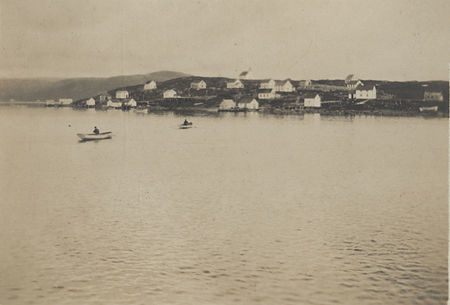The Red Bay Co-op
The Credit System in the Fishery
During his early visits to Labrador Grenfell became convinced that the chief cause of poverty among the fishermen and their families was the infamous credit system that was the basis of the fishery of Newfoundland and Labrador. In the spring the fishermen obtained supplies on credit from the local merchant. At the end of the fishing season the salted and dried cod fish was turned over to the merchant to settle the debt. The fishermen received any balance in the form of food and supplies for the winter.
In the event that the catch was not enough to cover the debt, those winter supplies were advanced on credit, applied to the existing debt and carried over to the next year. This system created an endless cycle of debt from which the fishermen rarely escaped. The concept of co-operatives had proven successful in the north of England, and Grenfell had spent some time there learning how the system worked. He was convinced that this was the solution to the problems caused by the credit system in Labrador.
Birth of the Co-operative
The fishermen of Red Bay experienced a particularly bad year in 1895. According to Grenfell, they were very discouraged by their poor catch when he arrived in the community late that summer; they felt that they could no longer survive in the Labrador coast.
Grenfell saw this as an opportunity, and explained the co-operative system and how it worked to William Y. Pike, one of the few fishermen in Red Bay who could read and write. He left Pike to convince his fellow fishermen to pool their resources and form a co-operative, an organization that would allow them to profit from their own labour.
When Grenfell returned later that fall he was disappointed to find that the fishermen were not interested in his idea. Few of them had enough money to invest, and a general fear of the local merchant made them all hesitant to start such a venture. Over that winter Pike continued his efforts to convince his neighbours that a co-operative was what they needed.
By the time that Grenfell returned to Red Bay in August of 1896 he found that the fishery had been better that summer and the fishermen had saved every last penny to invest in what became known as the "Copper Store." A meeting was held and by the end of it the Red Bay Co-operative Society had come into existence with an investment capital of $85.00 — the co-operative movement of Newfoundland and Labrador was born in a fish store in Red Bay in August 1896.
Expansion and Decline
The society operated out of a fisherman's shed for several years, and by the early 1900s it was able to construct its own building. The Red Bay Co-op was able to sell fish and get supplies for its members at fair prices. Pleased with the success of the Co-operative venture at Red Bay, Grenfell urged other communities in the region to follow this example.
Before 1920 nine more co-ops were up and running in northern Newfoundland and the coast of Labrador, including those at St. Anthony, Cape St. Charles, Battle Harbour, Flower's Cove and West St. Modeste. World War I brought about an increased demand for fish in Europe and prosperity to the fishermen of the region. However, the price of fish declined sharply following the war, bringing an end to the short-lived prosperity. In Red Bay though, the co-op helped the community to survive those hard years in the fishery and the years of the Great Depression. Of the co-operatives that Grenfell helped establish, only those at Red Bay and St. Anthony survived.
The Red Bay Co-op continued to operate until the early 1940s, when it evolved into a private business that continued to operate for another 50 years.
Documents
Red Bay Cooperative Society Minute Book
Scanned version of the "Red Bay Cooperative Society Minute Book, with Rules and Regulations". (CHE Collection, CHE-ID #660).
The Copper Store: the Story of Newfoundland and Labrador's First Co-operative
A paper by Cindy Gibbons. March 25, 1997.
References
Sir Wilfred Grenfell wrote about the benefits of the cooperative movement in "The Credit System vs. Cooperation," Among the Deep Sea Fishers, Vol 19(2), July 1921, pp. 45-46.
http://collections.mun.ca/cdm/compoundobject/collection/hs_fisher/id/3795/rec/73
Sir Wilfred Grenfell reported on a visit to the Co-operative store at Red Bay in 1931 and told of the difficulties of the organization in selling their fish and acquiring food supplies for the winter on page 147 of "Last Thoughts on 1931," Among the Deep Sea Fishers, Vol 29(4), January 1932.
http://collections.mun.ca/cdm/compoundobject/collection/hs_fisher/id/8774/rec/114
A story entitled "Co-operative Stores Among Atlantic Fishermen" that was first published in the Labour Gazette in March 1903 and described Grenfell's work to establish co-operatives in Newfoundland and Labrador appeared in Among the Deep Sea Fishers, Vol 1(2), July 1903, pp. 8-9.
http://collections.mun.ca/cdm/compoundobject/collection/hs_fisher/id/12588/rec/2
An address by Ethel Gordon Muir to the American Labrador Branch of the Needlework Guild of America entitled "The People on the Labrador and Their Needs" mentioned the establishment of the Red Bay Co-op on page 35. It was published in Among the Deep Sea Fishers, Vol 8(2), July 1910.
http://collections.mun.ca/cdm/compoundobject/collection/hs_fisher/id/8463/rec/29
Mary Lane Dwight spent the summer of 1908 teaching at West St.Modeste. She described a visit to the Red Bay Co-operative Store in Red Bay with Dr. Grenfell on page 38 of "At Home Among the Fishermen," Among the Deep Sea Fishers, Vol 7(1), April 1909.
http://collections.mun.ca/cdm/compoundobject/collection/hs_fisher/id/12243/rec/24
"The Truck System," Chapter VIII of Vikings of Labrador, or Life and Medical Work among the Fishermen of Labrador. London: Marshall, 1895.
https://archive.org/details/b24868723
Gibbons, Cindy. "The Copper Store: The Story of Newfoundland and Labrador's First Co-operative," March 25, 1997.














